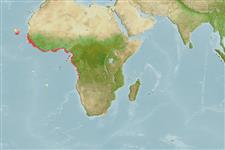分類 / Names
共通名の | 類義語 | Catalog of Fishes(部類, 種) | ITIS | CoL | WoRMS | Cloffa
>
Carangiformes (Jacks) >
Carangidae (Jacks and pompanos) > Caranginae
Etymology: Caranx: French, carangue, the name of a Caribbean fish; 1836 (Ref. 45335); fischeri: Named for Dr. Walter Fischer (1929-2023), for his vision and dedication in initiating the Species Identification and Data Programme of the Food and Agriculture Organization of the United Nations (Fischer, 1989), which in numerous ways, this program has been an invaluable resource for marine fisheries biologists and ichthyologists.
Eponymy: Dr Walter Fischer worked for the Marine Resources Department of the UN Food and Agriculture Organisation. [...] (Ref. 128868), visit book page.
Environment: milieu / climate zone / depth range / distribution range
生態学
海; 新鮮な水; 汽水性の; 深さの範囲 6 - 25 m (Ref. 58464). Tropical
Eastern Atlantic, including the Mediterranean Sea and Ascension Island.
サイズ / 重さ / 年齢
Maturity: Lm ? range ? - ? cm
Max length : 100.0 cm FL オス/雌雄の選別がない; (Ref. 58464); 最大公表体重: 26.0 kg (Ref. 58464)
背面の脊椎 (合計) : 9; 背鰭 (合計) : 21 - 24; 肛門の骨: 3; 臀鰭: 17 - 19; 脊つい: 24. This species is a member of the Caranx hippos complex, and is distinguished by the following characters: segmented dorsal-fin rays 21-23 (exceptionally 24); segmented anal-fin rays 17-19, usually 18; posttemporal bones are hyperossified in specimens larger than 20 cm FL; cleithrum, first pterygiophore of dorsal and anal fins, and neural spines of vertebrae are relatively slender and never hyperossified; in specimens >20 cm FL, heights of longest dorsal-and anal-fin rays are both 0.7-1.3 in head length; in adults, anal-fin lobe white anteriorly and remainder of fin is gray to brown (Ref. 58464).
This species is reported to occur in moderate to large schools in coastal areas, estuaries and lagoons that are essential habitat for juveniles and young. Reports that it descends far up coastal rivers to spawn are unconfirmed and true freshwater occurrence is doubtful, but there are verified collections of juveniles from three separate coastal river drainages. Feeds mainly on fish, shrimp and other invertebrates. It has been a focus of commercial interest and may be utilized fresh, frozen, smoked, dried-salted and for oil and fishmeal, with edibility reported as poor to good, and taste improves when bleeding upon landing is done (Ref. 109259).
Life cycle and mating behavior
成熟 | 繁殖 | 放精 | 卵 | 生産力 | 幼生
Smith-Vaniz, W.F. and K.E. Carpenter, 2007. Review of the crevalle jacks, Caranx hippos complex (Teleostei: Carangidae), with a description of a new species from West Africa. Fish. Bull. 105(2):207-233. (Ref. 58464)
IUCNのレッドリストの状況は (Ref. 130435: Version 2024-1)
Human uses
水産業:
用具
特記事項
XMLをダウンロードして下さい
インターネットの情報源
Estimates based on models
Preferred temperature (Ref.
123201): 16.2 - 25.7, mean 19.7 °C (based on 72 cells).
Phylogenetic diversity index (Ref.
82804): PD
50 = 0.5000 [Uniqueness, from 0.5 = low to 2.0 = high].
Bayesian length-weight: a=0.01660 (0.00767 - 0.03591), b=2.96 (2.79 - 3.13), in cm total length, based on LWR estimates for this Genus-body shape (Ref.
93245).
栄養段階 (Ref.
69278): 4.2 ±0.7 se; based on size and trophs of closest relatives
回復力 (Ref.
120179): 手段, 1.4年~4.4年の倍増期間の最小個体群 (Preliminary K or Fecundity.).
Fishing Vulnerability (Ref.
59153): High to very high vulnerability (67 of 100).
